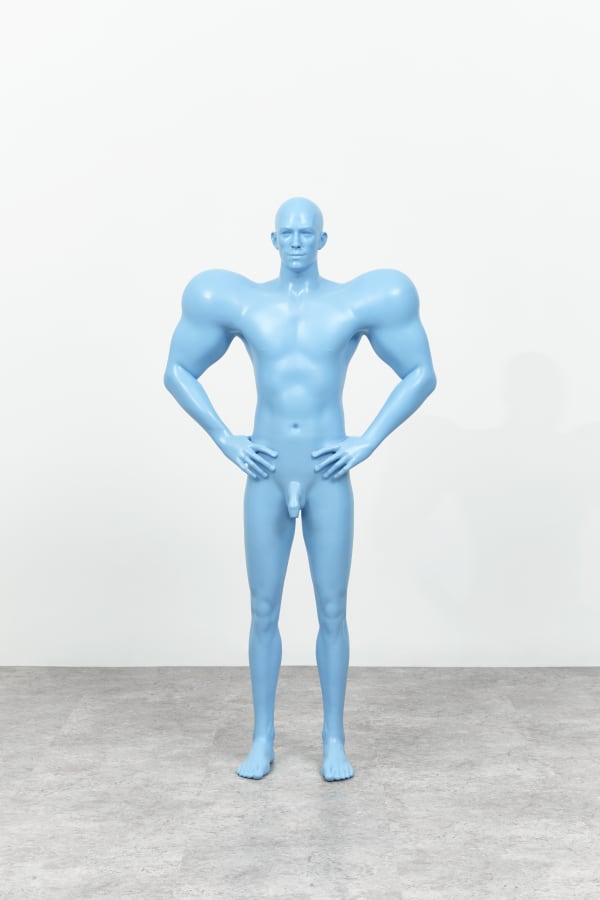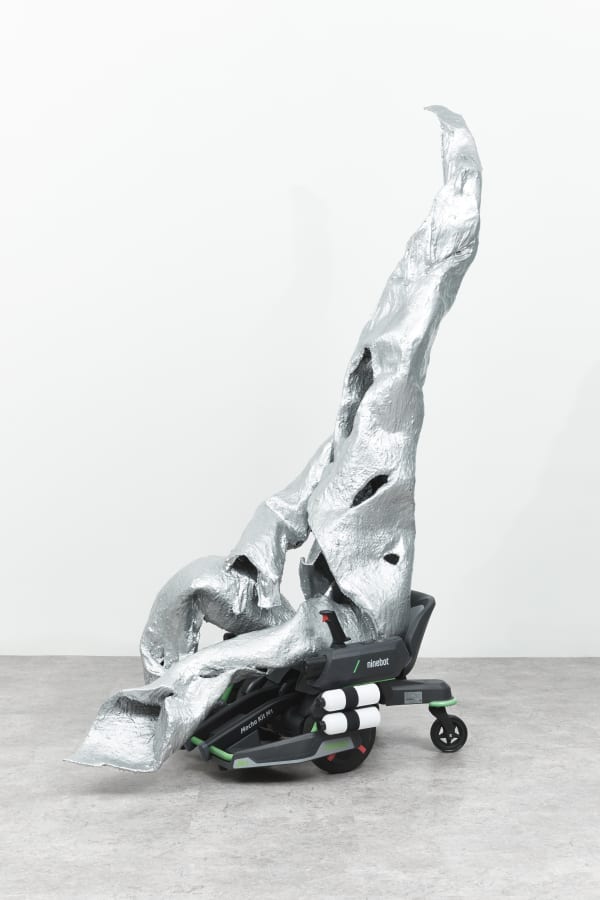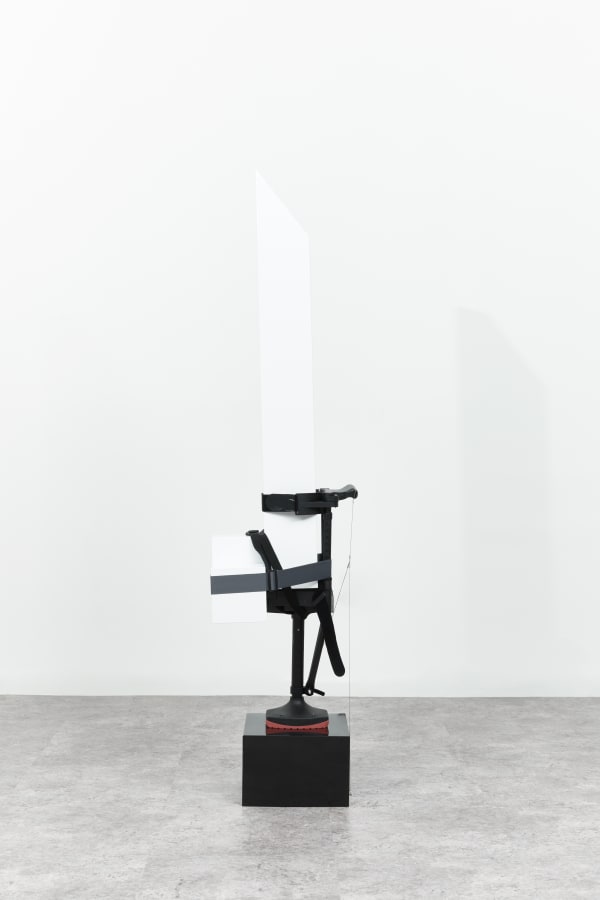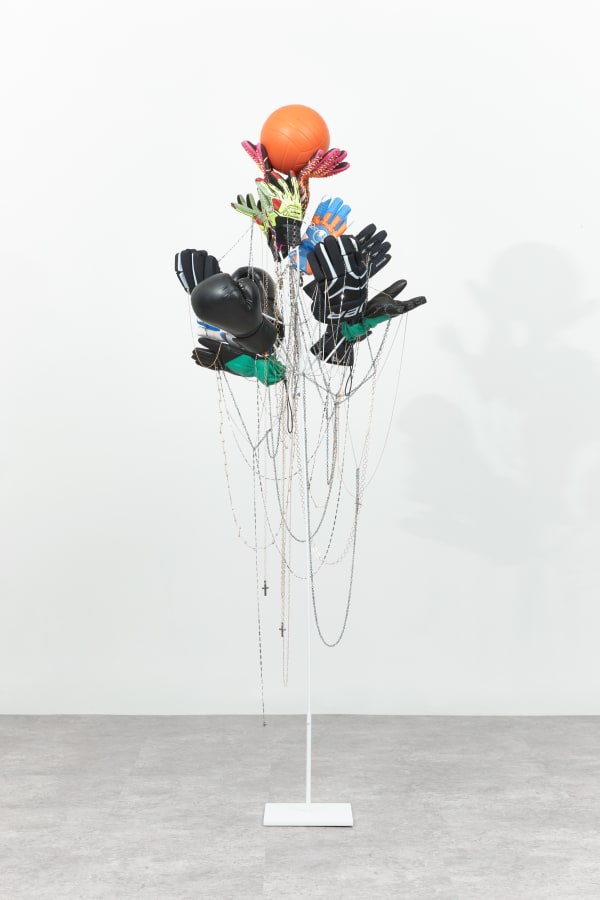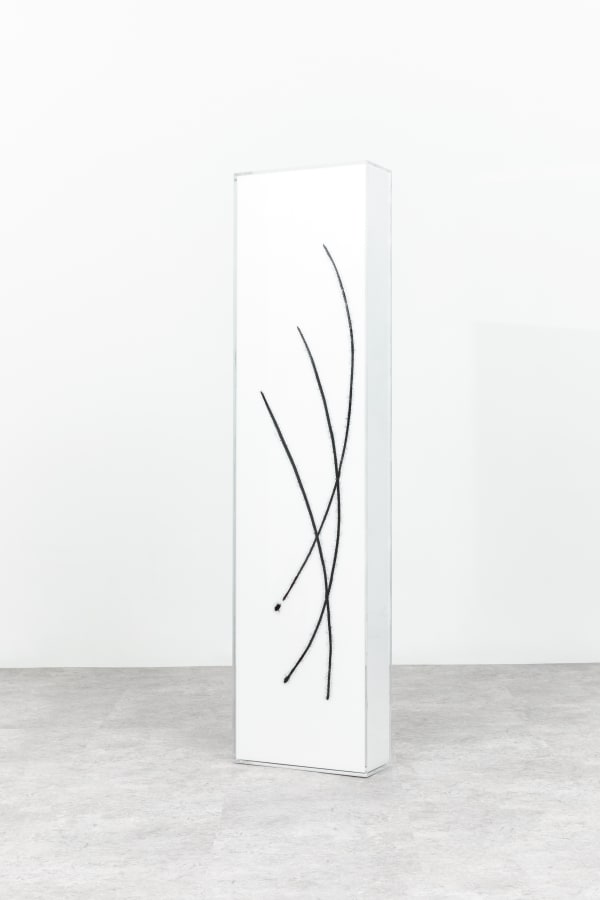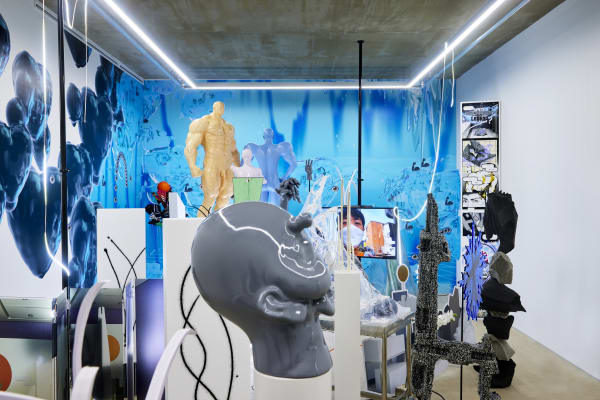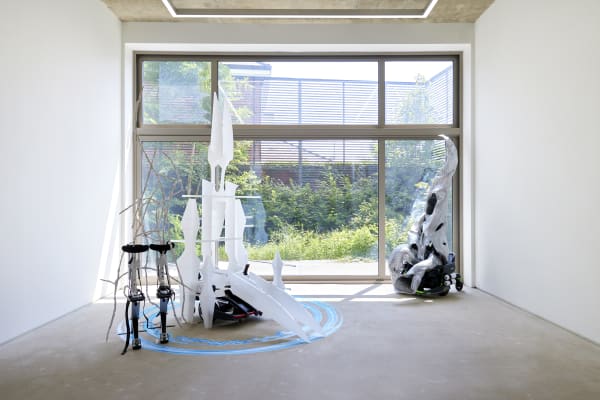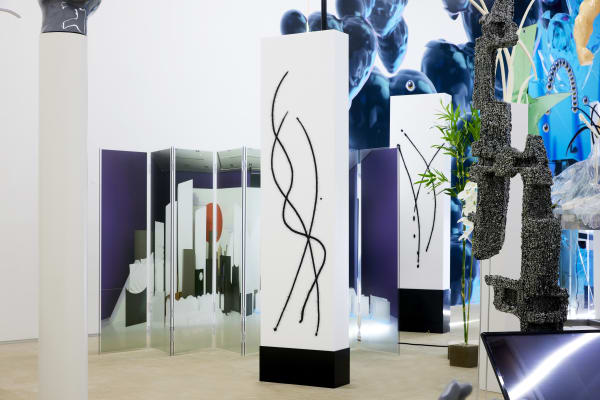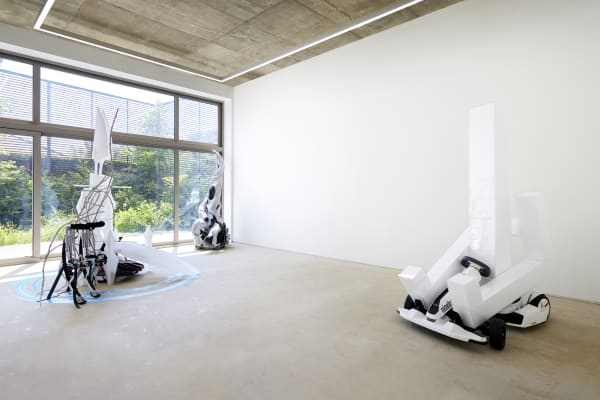태 Manner: 최하늘 Haneyl Choi
Forms as they should be
글: 전효경
최하늘은 몸이나 몸 일부의 형태를 따라 조각을 만든다. 대부분의 작품은 연작으로 제작되어 있고, 연작들은 서로 연결된다. 손 조각 여러 개는 모두 기형이다. 느끼할 정도로 과하게 매끈한, 산업 플라스틱에서 온 질감을 가지고 있는 오브제라 거부감은 어느 정도 상쇄되지만 실제로 이렇게 생긴 사람의 손을 본다면 아마 놀라지 않을 수 없을 것이다. 손은 몸의 여러 부분 중 얼굴 다음으로 가장 먼저 보이는 곳이라, 여러 형식의 기형이나 장애를 판단하기에 결정적인 실마리가 된다. 최하늘은 이를 가지고 명백하게 '정상'이 아닌 신체를, 망가지지 않은 단단한 재질로 보여준다.
가장 온전하게 몸 전체를 재현한 작품으로는 남성의 몸 입상 세 점이 있다. 플라스틱의 종류인 FRP로 만들어져 있어 빈틈없고 단단한 마네킹 같은데 어딘가 이상하다. SF 영화에나 나올 것 같은 극단의 남성성을 가지고 있는 조각은 근육이 비정상적으로 발달되어 있고 핏줄이 막 터질 것처럼 우락부락하다. 애초에 마초성을 의태하여 탄생한 것으로 보인다. 그 옆에 나란히 선, 키가 비교적 작은 남성의 신체는 팔이 잘린 채 둔부를 뒤로 빼며 강조하고 있다. 마조히즘의 형태를 비유하듯 매우 수동적인 자세를 하고 있다. 나란히 서있는 또 다른 조각은 반면 어깨가 부풀려져 있고 과시적인 자세를 취한다. 건조하게 서 있는 이 세 몸들의 관계성에 대해서는 모종의 권력 구조를 가지고 있는 것처럼 보였고 세 몸을 주인공으로 하는 어떤 이야기를 상상을 하게 만들었다.
꽤 두터운 다리를 가진 스케이트보드를 타는 조각이 있다. 신발을 신지 않은 채 스케이트보드 위에 올라 타 있다. 신발 없이 스케이트보드를 타는 것은 매우 위험한 일이다. 그래서인지 이 세팅은 힘없이 허구적으로 보인다. 조각의 반지르르한 질감이나 신체와 연결된 추상적인 모양을 보면 언뜻 모더니즘적인 형태를 가진 것 같지만 스케이트보드와 같은 일상적인 레디메이드 오브제와 접합하면서 그 역사적인 무게감을 던다. 무게감을 덜었다고 해서 조각에 속도감이 생긴 것은 아니다. 속도에 대한 작가의 대응 방식은 카트 위에 앉아 있는 신체의 모양을 닮은 조각에서도 알 수 있다. 최하늘은 예전부터 신체를 비유하는 조각을 기계와 접붙인 모습으로 제시해왔다. 그렇지만 이 작품들에는 바퀴처럼 속도를 낼 수 있음을 암시하는 실마리만 있을 뿐 운동성을 갖지는 않는다. 속도를 응당 가져야 하는 오브제들은 최하늘의 조각이 되면서, 조각의 쓸모를 위해 원기능을 상실한다. 다시 말하면 작가가 이를 무능하게 만드는 것이다.
최하늘의 조각 중에는 몸의 형태를 사용하지 않은 조각들도 있다. 난 조각은 한국화의 난그리기 규칙을 따른 드로잉으로 만든 것이다. 난치기는 그리는 순서가 중요하고, 그에 따른 필치의 모양, 방향성, 속도, 무게 같은 것들을 정해진 대로 그리기를 요한다. 거듭된 연습을 통해 일필휘지의 방법을 익히는 것이 난치기이다. 그렇지만 사실 이 연작을 대하는 작가의 제스처는 거의 자동기술법에 가깝다. 작가는 일필휘지를 마스터하기 위해 난치기 작업을 한 것이 아니라 이 한국화의 관습을 전용하여 이를 모방한 제스처를 반복적으로 취하고 있기 때문이다. 그는 자신이 그린 난을 본 따 포맥스로 커팅하여 평면 드로잉을 입체적인 조각으로 바꾸었는데, 이 작업은 난치기 개념을 기반으로 기획되어 기술적으로 구현된 것이다. 이것과 닮은 것이 최하늘의 병풍 작업이다. 이는 난치기와는 반대로 자신이 입체로 작업했던 것을 평면으로 출력하여 이를 겹겹이 병풍처럼 세워놓은 것이다. 이미지는 평면이지만 세워져 놓은 모습을 감상하는 시점에서는 ‘입체적인 설치’ 작품이 된다. 작가는 이러한 제스처를 반복적으로 보여주는데 한국에서 미술 교육을 받은 사람에게 당연시 되었던 ‘입체감’ 등 미술과 어울리지 않는 규준에 대한 자신의 저항심을 자동기술법적으로 나타내는 것 같다.
이번 전시는 둘로 나뉜 공간을 가진 두 갤러리, 갤러리2와 P21에서 진행된다. 최하늘의 세계는 정상적인 몸과 기형적인 몸, 현실적인 것과 초현실적인 것, 구부러지는 것과 딱딱한 것, 음각과 양각과 같은 형식으로 데칼코마니처럼 나타난다. 모종의 이분화된 사고 구조 안에서 한 쌍의 세포가 개체 분열하듯이 짝을 이루고, 확장된다. 작품은 어떤 세밀한 계산을 기반으로 만들어지기도 하고 충동적인 제스처로 우연히 발생하기도 한다. 그러나 그렇게 만들어진 그의 작품은 당연히 이분화된 사고 구조를 증명하기 위한 것이 아니라 이상하고, 기형적인, 퀴어적 형태들의 뒤섞인 알레고리처럼 보인다. 각 형태들이 어떤 의미를 갖는지를 해석하기 보다는 그냥 그대로의 모습을 응시하면 정상이 아닌, 망가진 모양 혹은 미완의 형태에서 생긴 다른 에너지가 차츰 보이기 때문이다. 현실적인 한계들은 비현실적인 형태로 대치되기도 하고, 그 자체로 과장되어 나타나기도 한다. 그렇게 만들어진 것들과 시간을 보내면서 한계는 구체적으로 의식화되고, 어쩌면 극복된다. 망가진 것을 지우고, 그 부정적인 의미를 없애는 것이 아니라, 망가진 것을 그대로 안고, 새 의미를 찾는 방법을 택하는 것이다.
기형의 몸을 마주하는 순간은 허구이든 실제이든 일종의 충격적인 체험이 된다. 개인적인 경험을 덧붙여 설명하자면, 최근 병원에 병문안 차 갔다가 어느 환자의 발이 많이 부어있는 것을 보았다. 그의 하얀 발은 마르고 푸석했었는데, 피부가 늘어날 수 있는 최대치로 늘린 것처럼 부풀어 있었다. 엄지발가락은 일반적인 크기보다 거의 두 배나 되어 보였다. 그 부은 발 모양이 너무 낯설어서 자꾸 다시 생각이 났다. 어쩌면 작은 다름을 목격한 것이지만 나에게는 충격을 마주하는 순간이었다. 부은 발은 그 자체로 많은 것을 생각하게 했다. 그의 발을 붓게 만든 원인은 정확히 알 수 없지만, 세포의 비정상적인 분열, 혹은 바이러스의 침투 등으로 인해 생긴 것이고, 몸 안의 정상적인 신진대사가 파괴되었다는 증거였다.
체험이 반복되면 경험이 되고, 몸이 겪은 시간은 다시 어떤 몸을 만든다. 최하늘은 자신이 경험한 체험들의 집합으로서 경험이 다시 만든 몸을 결과적으로 보여준다. 이렇게 보드랍고 친절한 질감을 가진 조각들이 점잖은 형체를 하고 있지만, 어떤 과정을 거쳐 만들어 졌는지를 알 수 있다면 실은 파괴적인 의미를 가질 수도 있다. 조각의 언뜻 뭉그러진 형태가 정상이 아닌 것을 되려 위시하고 있는 듯해서 더 그렇다. 특히 최하늘은 작품을 만들기 위해 ‘정상적인’ 규준을 따르거나 혹은 그것을 떠나거나 둘 중 하나의 문제를 결정하는 경우가 많았다. (대부분은 그것을 떠나기로 결정하는 것 같다) 그에게 쌓인 결정의 체험이, 외부의 규준 없이도 의미를 가질 수 있는 몸의 경험을 만드는 것 아닐까. 우리가 각자의 망가진 모양을 안은 채 자신으로서 존재하는 법을 차츰 알게 되는 것처럼 말이다.
Flawed as They Should Be
Hyo Gyoung Jeon
Haneyl Choi creates sculptures with shapes of the body or parts of the body. Most of his works are made in series and each series is connected to each other. Several hand sculptures are abnormal. The pieces have an extremely smooth texture with its industrial plastic material base, which relieves any possible repulsion, yet if one where to actually see a person with such a hand, it would be pretty startling. The hand is the first visible part of the body after the face and can be a decisive hint for judging various forms of deformities or disabilities. With these hand pieces Choi represents bodies that are not appearing ‘normal’ using immaculate, solid materials.
The works representing whole body shapes are three standing sculptures of the male form. Made of FRP, a kind of plastic, they resemble well-manufactured mannequins but look somewhat strange. The piece with an excessive masculinity that may have been featured in SF movies, has abnormally developed muscles and its blood vessels are about to burst out. It seems to be made to symbolize masculinity. The piece of a relatively short male standing next to a macho one is emphasizing his buttocks by pulling them out with his arms cut off. As if personifying the form of masochism, the piece has a distinctively passive posture. Another piece standing by its side alternatively has bulging shoulders and a bragging pose. The relationship between these three pieces seems to create a certain power structure and made me imagine a fiction with them as the main characters.
There is a sculpture with a thick leg riding a skateboard. It is on a skateboard without a shoe on, which is a very dangerous thing to do in reality. Therefore the setting looks helplessly fictitious. When looking at the glossy texture and its abstract shapes attached to the leg part, one may call it a modernist piece at first glance. However the piece, combined with the daily ready-made object, in this case, a skateboard, displays weight emphasises the heaviness in history. However, reducing the weight does not mean it gains speed. The artist’s response to the speed can be seen from his series of sculptures sitting on karts. For a while now, Choi has shown sculptures characterized as a body combined with different kinds of machines. However in these works, there are clues that imply it can have speed such as wheels but with no mobility. Objects that are supposed to be mobile lose their original functions for the sake of being sculptures. To reiterate form before, the artist disenables it.
Some of Choi’s works do not involve the shape of the body. His orchid sculptures were made by his drawings following the Korean tradition of orchid black ink drawing. The orchid drawing strictly requires to follow the order of each stroke and to have the defining shape, orientation of each stroke and the drawing to be in appropriate speed and weight as guided. The orchid drawing is about drawing perfect strokes at one go, in the right composition, through repeated practice of the same strokes. However the artist’s manner toward this series is more automated. The artist did not try the orchid drawing to show perfectly trained strokes but he merely appropriates the Korean painting tradition and mimics its gestures in repetition. He turned a flat drawing into a three-dimensional sculpture by cutting foamed plastic modelled after his own orchid drawing. The work technically realizes the orchid drawing idea in three dimension. Similar to this are his works imitating the Korean traditional folding screen. Contrary to the orchid drawing pieces, the artist printed his previous three dimensional works on a flat surface and sets a layer of the printed images up like a series of folding screens. The images are flat but they become a ‘three-dimensional installation’ from the audience’s views in the exhibition. The artist repeatedly shows such gestures. By doing it in an automated way, he seems to mirror his resistance against the standards and stereotypes such as ideas of ‘mass’ or ‘three-dimensional effect’, which were overlooked by those who received art education in Korea.
The exhibition opens in two galleries with two separate spaces, Gallery 2 and P21. Choi’s oeuvres are unfolded like a binary decalcomania in the forms of normal and abnormal bodies, realistic and surreal, soft and rigid, engraved and embossed. They pair up and divide to reproduce like a fission of cells within a certain binary system. However his works created through such process are surely not to prove the dichotomised thought structure but to constitute allegories intermixed with strange, deformed, and odd shapes. If you stare at each shape, rather than interpreting what each form means, it’s possible to see different energy generating from the deformed, flawed shapes. Realistic limitations are replaced with non-realistic forms and sometimes they turn out to be in more exaggerated shapes. When spending a course of time with things made through such a process, it turns out that the limitations become concretely aware and some may be able to overcome. It’s not subtracting ruins and or getting rid of their negative meanings but choosing to find a new meaning whilst standing with the ruins.
The moment of encountering the deformed body can be a shocking experience whether it’s in fiction or reality. To elaborate it with my personal experience, I recently saw a patience’s foot badly swollen when I was in a hospital to visit one of my family members. His pale foot was dry and brittle, also puffy as if the skin had stretched to its maximum. His big toe looked almost twice its normal size. The swollen foot shape was so unfamiliar to me and lingered for a while. Perhaps it was just witnessing a little difference but it was a moment of shock to me. The swollen foot made me think. The precise cause of the swelling of his foot is unknown, but it may have been caused by abnormal cell division or penetration of a virus as such and a visual piece of apparent evidence that the metabolism in his body was disrupted.
When a happening is repeated, it becomes experience and due to that time the body has experienced it bares another body. Choi represents the bodies recreated by experiences as a collection of happenings. The sculptural works polished with soft, kind textures and gentle postures may have destructive meanings, if we get to know what process they were made through. It is even more so, as the crumbled shapes of the works seem to boast about themselves and their abnormality. In particular, Choi gets to choose whether he follows the norms or departs from them in doing his artistic practices—mostly it seems he decided to leave it. Doesn’t his accumulated experiences lead him to be able to make the decision to create the experience of the body to have meanings without relying on existing standards? Just as we gradually learn how to exist as ourselves, holding each of our own flawed forms.

